Coffee Grinder Types – Which One Beats Them All?
These are the main categories of coffee grinders you’ll find on the market in 2025:
- conical burr grinder (electric or manual)
- flat burr grinder
- automatic machine with built-in grinder
- blade grinder
The categories of conical vs flat burr, and manual vs electric burr grinders overlap, which is why there are 4 (or 5) categories 🙂
Which is best in my professional opinion? Let’s go into the details of each category.
Conical Burr Grinders
A burr grinder consists of two spinning burrs that grind the coffee between them. The beans are then crushed between the moving grinder wheel and a stationary surface.
A conical burr grinder is made up of two cone-shaped cutting discs with ridged edges that crush coffee beans by spinning against each other.
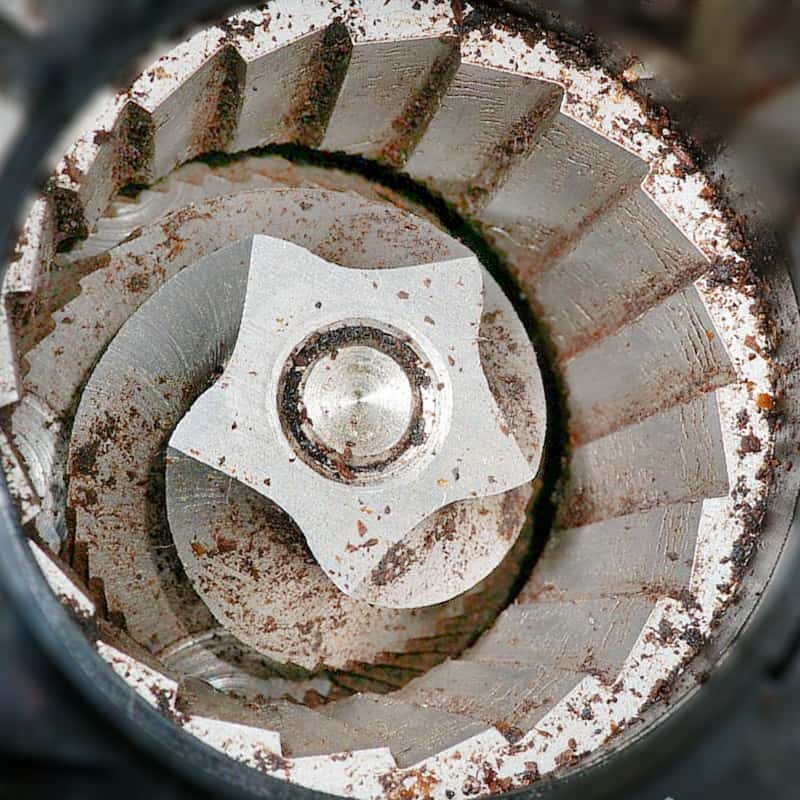
It is a mechanical system that works in 3 stages:
- One burr remains stationary while the other is rotated for grinding the beans.
- As the burr spins, the edges pull the beans into the grinding area,
- where the grounds are crushed into smaller pieces and fall down into the container that holds the grinds.
You can control the distance between the two discs to adjust the grind size you want.
Conical burr grinders are the most popular among coffee fans because of their:
- High level of grind control
- Consistent grind size
- Large grind surface
- Low heat
- Low noise
- Low energy cost
- Affordability (compared to flat burr grinders)
You can get manual, or electric burr grinders. The results are similar, but the grinders and process are very different.
- Manual – Hand grinders are an affordable investment that can be the gateway to enjoying coffee grinding. That’s because you have complete control of the grind setting. They’re also convenient because of their size and portability.
- Electric – They are easy to use and require less time and effort than manual coffee grinders. A high-quality electric coffee grinder is useful if you fancy drinking coffee daily, especially espresso. Here are some great electric burr grinders.

Flat Burr Grinders
Flat burrs are shaped quite differently yet operate similarly to conical burrs. Flat burrs are made up of two ring-shaped burrs with razor-sharp teeth that spin against each other. Coffee beans enter these burrs, which are grabbed using the burr’s inner teeth and then forced through to the outside edge of the burr.
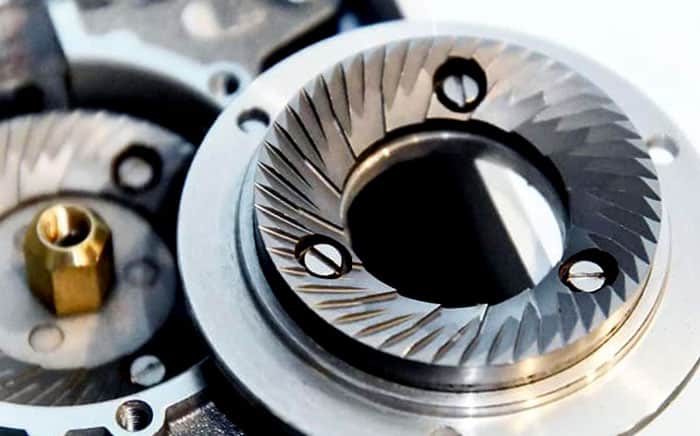
They usually have a stronger motor to do these grinds, producing higher heat and louder noise than conical burr coffee grinders.
Flat burrs are great because:
- They offer better control over coffee extraction.
- They produce extremely consistent grind size, which makes them perfect for espresso-related recipes.
Flat burr grinders are more expensive than conical ones, but the grinds produced aren’t that much better.
Automatic Coffee Machine with Built-In Grinders
Coffee machines that come with built-in grinders are made with convenience in mind.
Brewing coffee involves several steps, from grinding the beans to pouring them into your cup.
However, with a push of a button, these machines automate that process for you.
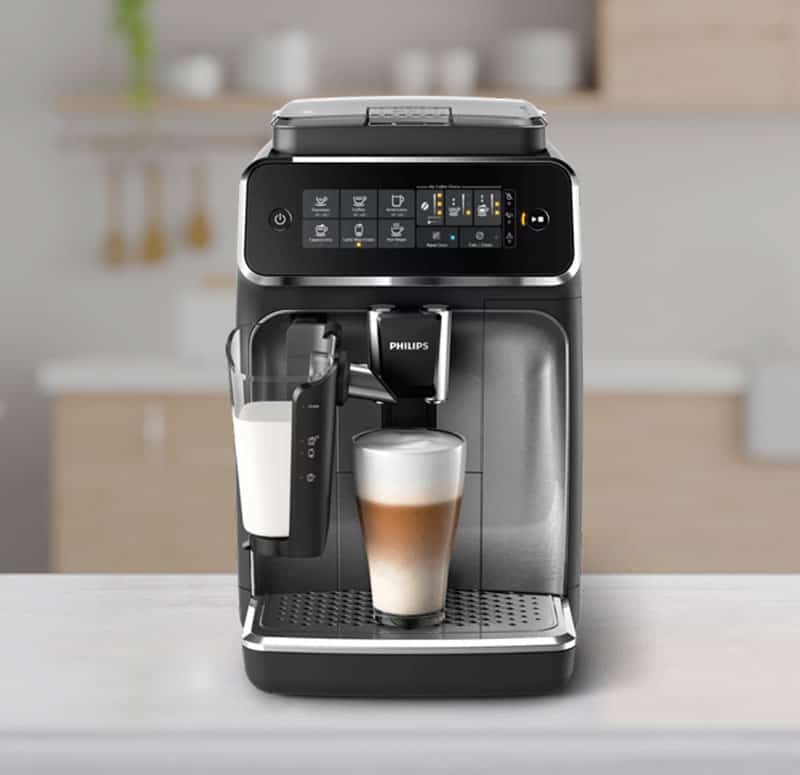
Most of the time, you only need to fill their beans, and they’ll do all the heavy lifting at that point.
Built-in grinders are great for:
- Convenience (if you are always busy with no time to grind your beans.)
- Simplicity if you want to have a cup ready in no time.
However, automatic coffee makers will never be able to produce great espresso, as there are too many factors involved. These machines cannot be fine-tuned to that extent, making the proper dialing-in of an espresso impossible.
Blade Grinders
Instead of crushing coffee beans like burr grinders, a blade grinder uses an electric motor to spin its propeller-like blade to chop coffee beans into tiny pieces.
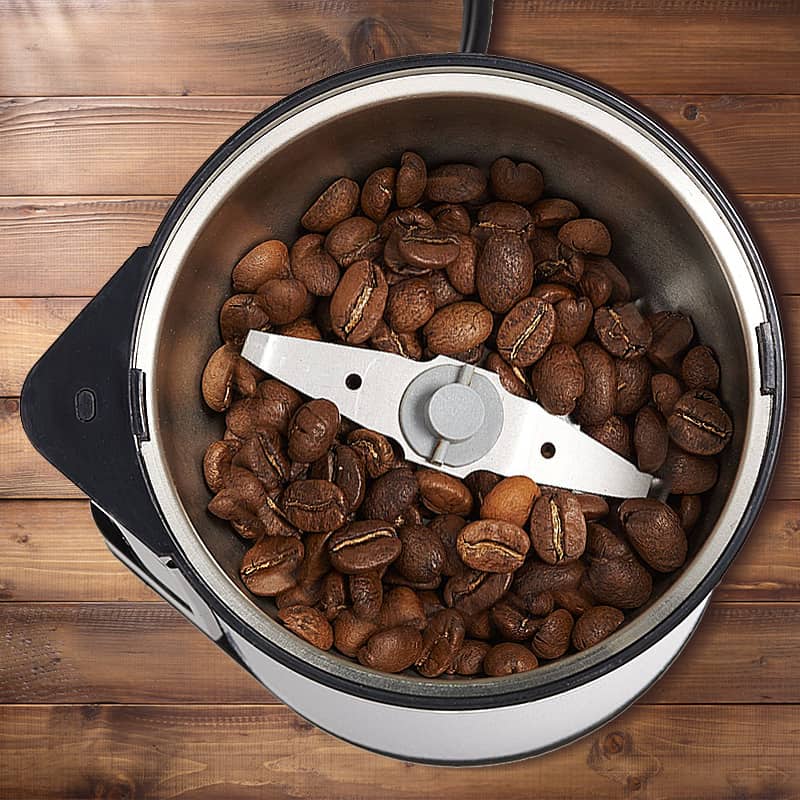
Blade coffee grinders are known for their affordability, but this comes at an “expense” to your brew.
Blade grinders are less likely to produce consistent, uniform coffee grounds.
They’re generally used as a last option because their cons outweigh all the pros, or by people who don’t really care about getting the maximum out of their coffee. Here are the common problems blade grinders face:
- You don’t have complete control of your expected grind size.
- They are prone to smashing the coffee beans into random and uneven particles that lead to an unpredictable cup that can be both under and over-extracted, since you can have both coffee dust and larger chunks in your grind.
- Its high RPM (rotations-per-minute) can heat up the coffee if you leave it running too long.
Here is a detailed article on burr vs blade coffee grinders if you are interested.
The Differences Between Grinders
Here are the factors you need to consider before investing in a coffee grinder. I used the word “investing” on purpose here, since it is a one-off expense that will serve you for many years.
Price
- Conical Burr Grinders – When it comes to getting your money’s worth, conical burrs are second to none. A cheap manual burr grinder can compete with most low-to-mid electric burr grinders on the market.
- Flat Burr Grinders– Flat burrs are a specialized type of grinder. If you are super serious about making quality espressos, then flat burrs are worth their price. If not, it’s best to stick with conical burrs.
- Built-In Grinders – When purchasing a super-automatic coffee maker with a built-in grinder, you’re paying for the convenience of the machine making coffee for you. And of course, you can’t use the grinds anywhere else, just in the drink the machine prepares. Looking at it from this point of view, these built-in grinders are not worth their price tags.
- Blade Grinders – Blade grinders are less expensive than burr grinders, but they’re a mediocre choice when considering their price tag. The cheaper manual conical burr grinders can do their job better every step of the way.
High vs low-speed grinding
When it comes to speed, both have their own advantages and disadvantages.
- Low-speed grinding ensures less heat is transferred from your grinder’s burrs to your beans during grinding, resulting in a better-tasting coffee with more of its natural oils preserved.
On top of that, lower speeds mean quieter operation, which means no waking up my neighbors when making your morning cup of coffee. Conical burrs do this job very well. - High-speed grinding can be quicker, but you have to take the noise factor and higher temperatures generated throughout the process into account. They’re not ideal if you’re looking for optimum flavor extraction.
Blade grinders use high-speed “grinding”, so be careful!
Stepped vs stepless adjustment
You only need to worry about stepped vs stepless grinders if you want to dial in espresso.
- A stepped coffee grinder has a series of pre-set grind settings, each with a specific level of fineness such as coarse or fine.
- Stepless grinders allow you to adjust their grinding settings infinitely between coarse and fine without any set increments in between. This method offers more control over the grind size for brewing espresso or other specialty coffees.
This is not to say that stepped grinders can’t be used to dial in espresso.
For example, my 1zpresso Kmax is a stepped manual grinder, with 8.8 microns (0.0088 mm) between each step! As a comparison, the width of your hair is around 70 microns…
How fine it can grind
All coffee grinders can grind coarse, but not many can grind fine. Again, this is applicable to you if you want to prepare espresso or Turkish coffee.
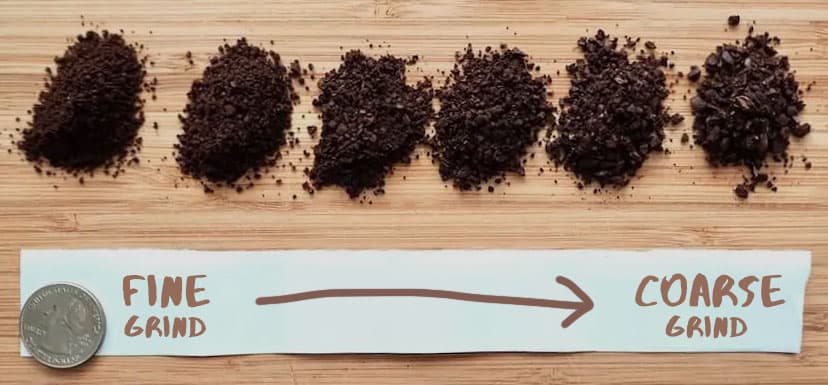
- Burr Grinders – Most burr coffee grinders come with a range of settings that let you grind coffee beans from coarse to very fine, depending on the type of beverage you’re grinding the beans for. They’re adaptable to any grind size you fancy.
However, in the “fine” range, many grinders are limited in their adjustability. - Built-In Grinders – Coffee makers with built-in grinders typically have a limited number of grind sizes available, and these sizes often skip specific grind sizes (many built-in grinders only offer course, medium, and fine sizes rather than providing a range of intermediate options.)
- Blade Grinders – Blade grinders can grind the coffee beans all the way from coarse to very fine but offer inconsistent grind sizes.
You can view a detailed infographic for more information about different grind sizes here.
Ceramic vs stainless steel
Comparing the difference between ceramic and stainless steel burrs is tough.
- Ceramic burrs are made from an ultra-hard material known for their sharpness and longevity – making them ideal for grinding your favorite beans with precision. Ceramic also retains less heat than metal alternatives, so it won’t burn away any of the flavors or aromas in your brew like some other materials might. On top of this, since ceramic is denser than most metals, it will take longer to wear down over time which means fewer replacements! However, they are more brittle and prone to breaking if used improperly.
- On the flip side we have stainless steel burrs which are typically more common due to their affordability and durability. Stainless steel can withstand higher speeds without causing damage or leaving bits behind while still delivering consistent results as well – something not easily achieved by other types of blades. Plus, they don’t require as much maintenance as ceramics do if properly cared for.
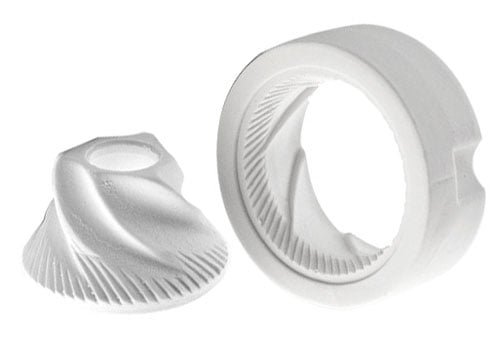
Each has its own set of advantages and disadvantages that should be taken into account, but no matter which one you choose, either ceramic or stainless steel burrs will give you an excellent grind for any type of brewing method.
Cleaning, maintenance, and repair
Keeping your coffee gear performing well depends a lot on how you take care if them.
Burr Grinders – Cleaning a burr grinder can be tedious and time-consuming, but it is worth it and should be done 1x per month. You’ll remove the oils that build up on the burrs, and get better tasting coffee.
Built-In Grinders – These grinders are prone to breaking down over time, and when this happens, it can render the entire machine useless. You usually need to replace the grinder motor, which somehow always happens right after the machine’s warranty period ends.
While many coffee brands offer repair services, using separate grinders and coffee makers can be more convenient. This way, if one component breaks down, it is easily replaceable.
Blade Grinders – Blade grinders are incredibly easy to maintain. An easy way is to fill it with uncooked rice and run it for about a minute to remove excess coffee grounds and oils.
You can repeat this process until the grinder is clean, then unplug the grinder and wipe down the inside with a damp cloth or paper towel.
Your brewing method
The brewing methods you use at home will have a great impact on which grinder you’ll need to choose.
- Not all burr grinders can grind fine enough for espresso.
- Not all grinders are consistent enough for coarse cold brew.
So when you read the reviews of a grinder, make sure it can do what you want it to do.
Are Cheap Coffee Grinders Any Good?
It depends on what type of grinder you’re eyeing to get.
Blade grinders are the cheapest in the mix and the most-beginner friendly, but I strongly recommend getting an entry-level, manual burr grinder above all else.
Why manual, you ask?
A cheap electric blade grinder won’t do you any good. In fact, it will even be detrimental for you to achieve a consistent and uniform grind. These kinds of grinders are equipped with cheap motors that offset that disadvantage by spinning faster to crush coffee beans.
Cheaper manual grinders, on the other hand, will go a long way and is actually a better investment in both quality and price. A $50 manual grinder with a little bit of patience and elbow grease will outperform a $100 electric grinder any day of the week.

If you’re looking for something beginner-friendly that would get the most bang for your buck, I recommend giving manual grinders a try.
Upgrading Your Burrs
If you find your burr grinder lacking in performance but don’t want to spend more money by purchasing a better grinder, you can also opt to upgrade its burr set.
The SSP burrs (Sung Sim Precision burrs) are the popular pick among coffee enthusiasts for this kind of upgrade. These come in flat and conical variants and are available in different sizes. Just be sure to check which one is compatible with your grinder.
These burrs can help with the precision and consistency of your grinds across different brewing methods, from the coarse coffee grounds of cold brew to the fine espresso grind.
Why should you grind coffee beans yourself?
Grinding your own coffee beans has many advantages, and is becoming increasingly popular in homes across the world.
Whether you’re an experienced barista or simply a home brewer looking to get more out of their morning cup of joe, having your own grinder can make all the difference.
From fresher grounds to better extraction, let’s take a look at why it pays off to grind coffee beans yourself:
- Nothing beats the aroma of freshly ground coffee beans – you can enjoy an intense, full-bodied flavor and take your morning brew to a whole new level!
- Grinding your own beans ensures that they remain fresh until brewing, meaning more of the natural oils created during roasting are preserved for maximum taste impact.
- By grinding just before use, you have complete control over how fine or coarse the grounds end up being – it all depends on what type and strength of coffee you’re looking for!
- With DIY grinding comes better value because buying pre-ground is often much more expensive than buying bulk beans in bags from specialty shops or online retailers.
Should You Grind Lots of Coffee Beans All at Once?
No. Grinding your coffee beans in a batch ruins the freshness of your coffee, because the tiny particles will be exposed to air and undergo oxidation. They lose their aroma, the oils dry, and you get stale coffee very quickly.
When coffee beans are still whole, their outer husks serve as shields to protect the coffee bean from oxidation. However, once you grind them into evenly ground coffee, you only have about 15 minutes to enjoy their peak freshness before oxygen starts to break them down.
Coffee grounds undergoing this process can:
- lose flavor through oxidation
- cause chemical compounds to degrade (which will add inconsistent flavor)
- make natural oils and fats break down and turn rancid.
The only workaround to that problem is by grinding only the serving size you need and immediately brewing it.
That way, you minimize the coffee bean’s oxidation time while capturing its natural flavor.

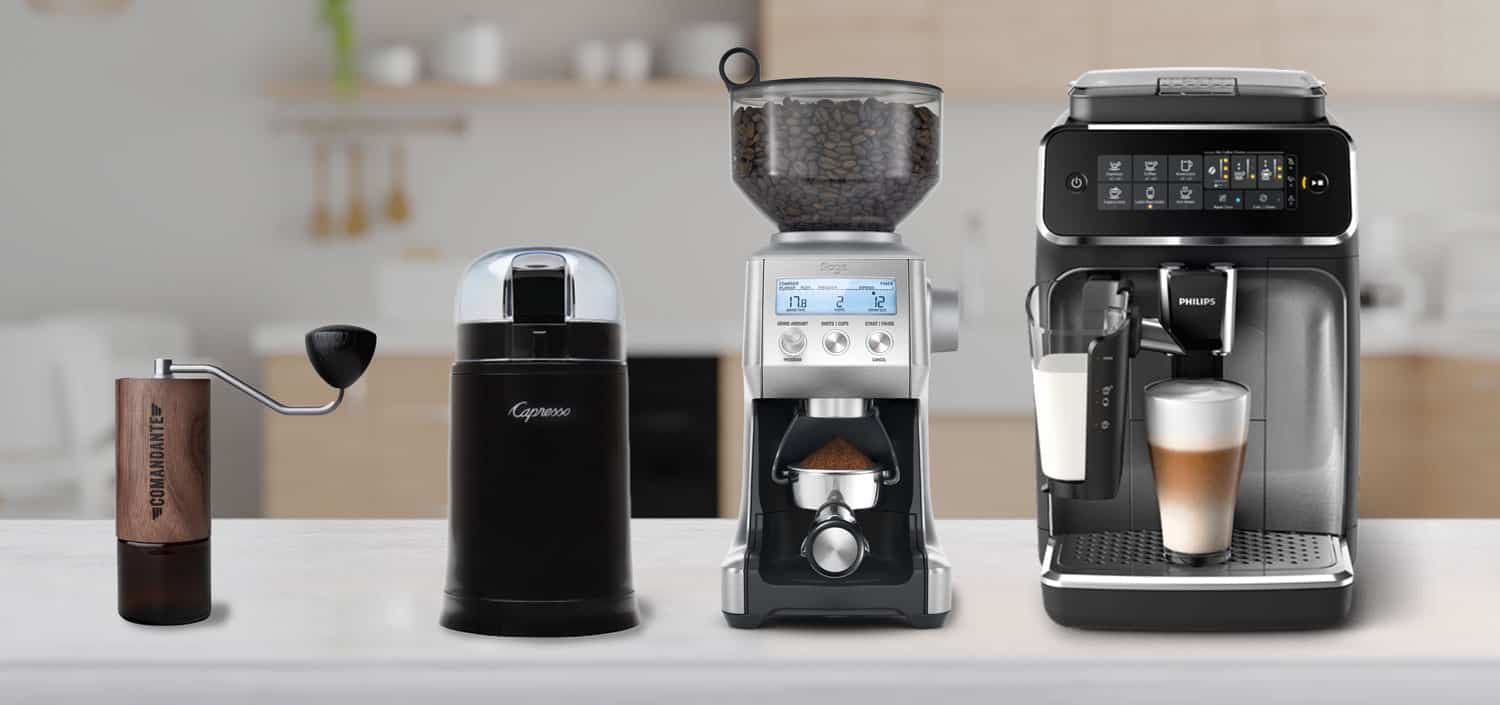
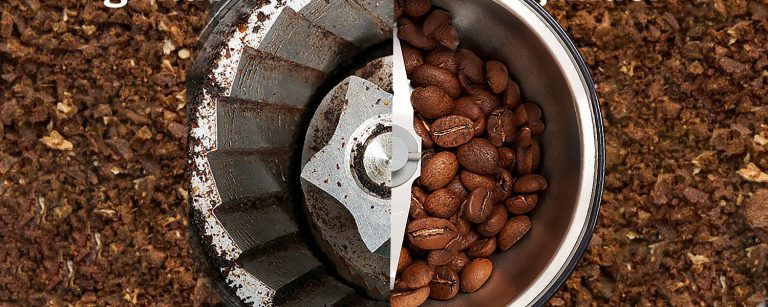
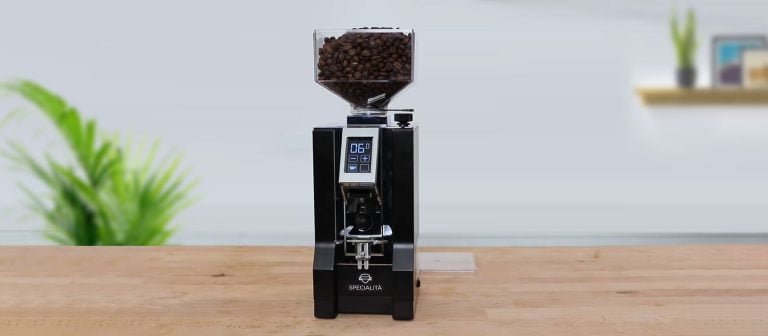
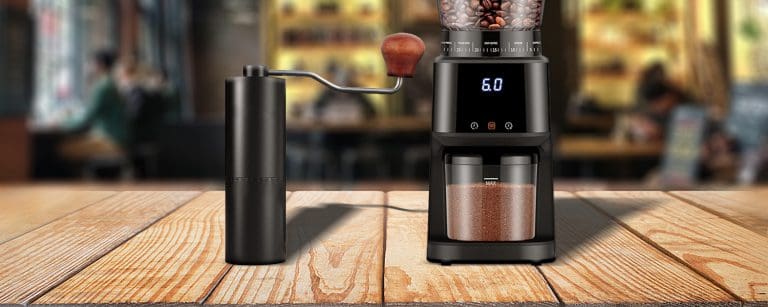
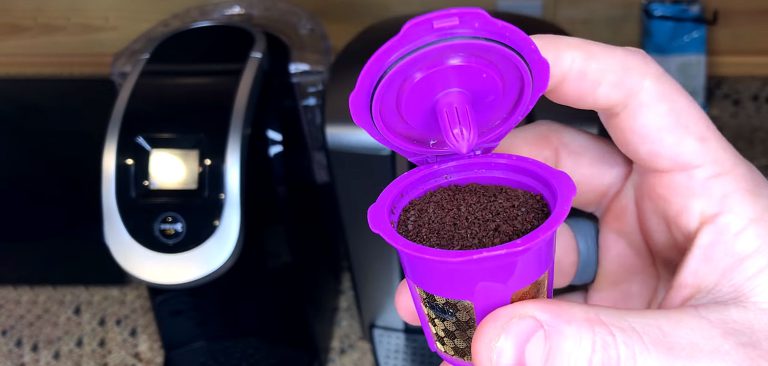
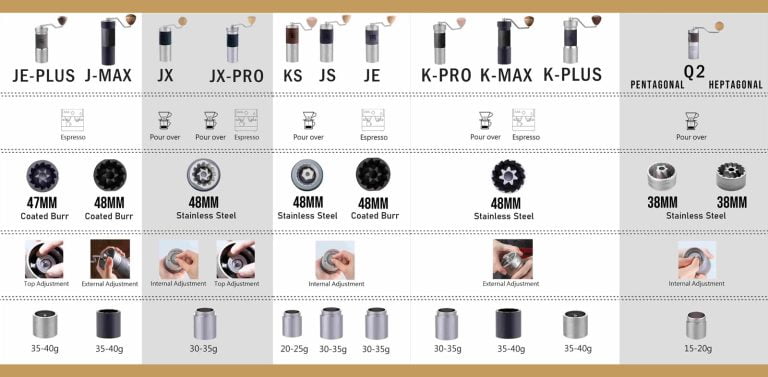


I’ve been in the coffee game for quite a while, and I can attest to the superior consistency of flat burr grinders. Tom mentioned their precision for espresso shots, which is spot on. However, home baristas should weigh the noise aspects before investing. That was not mentioned in the article. Some electric grinders are painfully loud.
After reading this article, I went ahead and bought a conical burr grinder (Baratza ESP) for my morning brew, and the difference is night and day.
Can anyone elaborate on the high vs low-speed grindingsection? I’m interested in how the speed might affect the taste of my coffee. Do faster grinds produce a bitter flavor, or is it more about the heat generated?
Quite intrigued by your point on ceramic vs stainless steelburrs. I’ve always used stainless steel and found it very durable and consistent. Could you explain the benefits of ceramic, and is it true they stay sharper for longer periods?
I’ve never had a burr break, but depending on how much you use them, they might get blunter and need replacing. When they go blunt, they won’t grind with the same effectiveness and to the same degree. But with that said, most people will not notice any difference…
I’ve noticed several people mentioning that cheap grinders aren’t much good. But honestly, after using a budget-friendly blade grinder post-college, I found that the convenience and price point made it a good fit for someone not overly concerned with achieving the perfect grind. It’s worth remembering that not all coffee drinkers are connoisseurs, and there is a place for simplicity in the market.
Sorry but I don’t agree. You might as well just buy pre-ground coffee and not have to “grind” at all, that will be more uniform than what a blade grinder can produce.